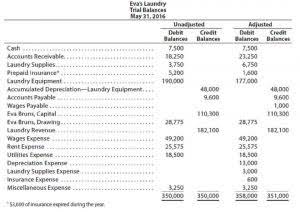Content
- General Ledger Account Definitions
- The Different Types Of General Ledger Account
- Create Or Reverse Journal Vouchers
- How A General Ledger Works
- How You Access The General Ledger
- Payroll Suspense Cost Objects
- What Is A General Ledger Gl?
- Overview: What Is A General Ledger In Accounting?
- Dispose Of Surplus Equipment

This includes income from sales, interest, discount received, dividend, investment . The Accounts Receivable account in the next figure increases with debits and decreases with credits.
All costs incurred for services rendered during short-term employment by individuals who cannot be classified as independent contractors. All costs incurred representing additional compensation for instruction during the summer quarter for faculty on 9 months service appointments or on term appointments. If you already have a Debitoor account, you’ve probably discovered that it doesn’t have a typical layout for numbered accounts. Income is registered as it is entered on invoices or received directly through online payment or bank statement uploads. ProfitabilityProfitability refers to a company’s ability to generate revenue and maximize profit above its expenditure and operational costs. It is measured using specific ratios such as gross profit margin, EBITDA, and net profit margin. One can’t imagine a balanced trial balance without proper preparation of general ledgers.
General Ledger Account Definitions
In accounting, a general ledger is used to record all of a company’s transactions. Within a general ledger, transactional data is organized into assets, liabilities, revenues, expenses, and owner’s equity. After each sub-ledger has been closed out, the accountant prepares the trial balance.
- These payments consist of fellowships and non-taxable stipends paid on the monthly payroll and the monthly fellowship payroll.
- Debit “expense” and credit “cash” in both the journal and the ledger.
- It consists of seven numeric digits representing the natural account classification.
- Here is an example of an accounting system transaction within a general ledger for a fictional account, ABCDEFGH Software.
- This makes it is possible to buy goods or services from a supplier on credit rather than paying cash up front.
The open source online analytical transaction processing DBaaS startup takes a different approach to accelerate queries as it … The Structured Query Language comprises several different data types that allow it to store different types of information… Therefore, everyone within the company network can access the ledger at any point and make a personal copy of the ledger, making it a self-regulated system. This mitigates the risks that Centralized General Ledgers have from having one source control the ledger. The image below is a great illustration of how the blockchain distributed ledger works.
The Different Types Of General Ledger Account
All costs incurred for livestock purchases to hold for breeding or experimental purposes. Livestock purchases for immediate slaughter purposes should not be included here but under operating supplies . All costs incurred that are not properly includable in any of the other GL accounts in this list should be entered under this code. https://www.bookstime.com/ All costs incurred for honorariums and any other personal services not under a formal contract arrangement and not on a payroll. All costs incurred as the result of special contracts with other educational or government agencies for specific purposes. Examples are contracted personal services and special administrative charges.
- If Sales account credits exceed expense and cost account debits, then the company made a profit.
- Subaccount segment values for balance sheets will always be 0s and how they will be used for income statements has not been fully explored.
- Some examples of liabilities include loans, mortgages, and accrued expenses.
- The general ledger holds all the information for businesses to assess financial health.
- ExpensesAn expense is a cost incurred in completing any transaction by an organization, leading to either revenue generation creation of the asset, change in liability, or raising capital.
- A general ledger gives an overview of your business’s financial activity.
For accounting activity managed in the Oracle General Ledger, the Balancing segment of a GL income statement account string indicates the balance sheet to which that account string is related. For a GL balance sheet account string, the Balancing segment uniquely identifies the specific balance sheet. For income General Ledger Account statements, the Balancing segment value is always identical to the Balancing segment value of the balance sheet account string to which it relates. The first two digits of the Balancing segment indicate the internal functional grouping. The Sales account in the figure below isn’t a balance sheet account.
A GL also provides financial accounting records for all of an organization’s business transactions and account balances. These records and the financial data they contain can help accountants spot unusual, erroneous or fraudulent transactions. Consider the following example where a company receives a $1,000 payment from a client for its services. The accountant would then increase the asset column by $1,000 and subtract $1,000 from accounts receivable. The equation remains in balance, as the equivalent increase and decrease affect one side—the asset side—of the accounting equation. In limited cases, a balance sheet account string will have no related income statement account strings at all.
Create Or Reverse Journal Vouchers
All costs incurred for specialized services provided by other University departments such as photographic services, health care, central administration charges, etc. All costs incurred for patient costs per special grant or contract arrangements.

Those with debit balances are separated from the ones with credit balances. The debit and credit accounts are then totaled to verify that the two are equal.
It also gives you a quick overview of your organization’s financial health. For instance, if you were recording an asset, the sub-accounts might include savings, inventory or accounts receivable. Revenue sub-accounts could consist of product sales or miscellaneous income earned. The general ledger accounts in your accounting software and Autotask PSA must match exactly so, to begin, print a list of your general ledger accounts. Agencies/departments must be able to report accounting information to the lowest hierarchical level.
How A General Ledger Works
This differs from 361 – Maintenance and Repairs in that it is really a major reconditioning process, not for general minor improvements. All costs incurred for overtime worked by Clerical/Technical/Maintenance personnel paid on the monthly salary payroll.
Accountants can zero down to bleeding Cost Centres and propose solutions for business units in Organizations. General ledgers have the columns of date, description, debit and credit amount. The description could be an expense, revenue, liability, asset or equity entry. As discussed before, the financial entries are first recorded in a general journal. For example, goods purchased with cash will be recorded in the the general journal as a journal entry. The journal entry will debit goods as an asset and credit cash as it will be going out or reducing to purchase the goods.
Your software of choice will probably have an option to “View general ledger,” which will show you all the journal entries you’ve entered . If there’s an error and your books are out of balance, you’ll need to go back to make changes and create an adjusted trial balance or adjusting entries. Using the information above, you can create an income statement or balance sheet for your business. Your income statement tracks your income, while your balance sheet tells you how much money you have and owe.
- For a small business owner, understanding how general ledger accounting works can be very helpful.
- The expense side of the income statement might be based on GL accounts for interest expenses and advertising expenses.
- Certified public accountants and bookkeepers typically are the ones accessing and using general ledgers.
- The sub-ledgers you use will depend on what type of business you run.
- These accounts include assets, liabilities, and stockholders’ equity.
The general ledger is an essential part of your accounting and bookkeeping processes. The general ledger serves as a repository for every transaction that is recorded, and is a must for any business using double-entry accounting. A general ledger is the set of all the numbered accounts that are used to keep track of every financial transaction that occurs in the course of business.
Debit Amount – All the debit entries of the account need to be recorded in this column. Remains free of accounting errors.Earlier, accountants made manual ledgers which were taxing. Over the years, computer applications have computerized the process to save time and minimize errors.
To get started, create a journal and record each business transaction as it occurs. Make sure each transaction is recorded with the correct account. Once your journal is completed, you’ll transfer this information to the general ledger. With the exception of some Subaccount segment values designated for institutional use by UAB , the Subaccount segment has meaning only within the context of each Account segment. This ledger pertains to the income earned by the company either from the main business of the entity or from other sources.
How You Access The General Ledger
If they aren’t, the accountant looks for errors in the accounts and journals. A GL enables a business to compile a trial balance where all debits and credits are totaled. Most organizations do this periodically, often at the end of a reporting period, so they can proactively stay on top of expenses. A general ledger account is an account or record used to sort, store and summarize a company’s transactions. These accounts are arranged in the general ledger with the balance sheet accounts appearing first followed by the income statement accounts.
Every financial transaction affecting the business is recorded in the general ledger, either as individual journal entries or as summarized totals from the general journals. One of the greatest benefits businesses realize from frequent general ledger accounting is access to real-time data and accurate reports.
Payroll Suspense Cost Objects
Information may come from bank and credit card statements, your point-of-sale system, invoices, receipts, and more. Organizing your accounting steps and processes is essential in proper double-entry accounting.

The Account segment is the first segment of the GL accounting key. The Account segment consists of seven numeric digits and identifies the primary activity for which money is being spent. The first five segments of the accounting key are also referred to as the account string or the ASBOF — that is, the first five segments without the object code.
Use Aavenir Invoiceflow reports seeing a complete list of invoices from all vendors within a date range. You can select only the vendors you want the report to identify cost of specific type of vendors or per business unit. Many organizations continue to struggle with spreadsheets — or cling to on-premises Finance Planning & Accounting (FP&A) solutions. Organizations can start using the right technology solution to drill down into accounting transaction detail in ledgers of business units and gain better insights and business outcomes.
Your general ledger acts as the backbone of your accounting function, meaning if there is an incorrect set up, the mistake could keep repeating itself, going undetected. In addition, JS Morlu can provide bookkeeping services to help your business regulate the general ledger through bank reconciliations and other general ledger procedures. For specific details on which maintenance procedures are right for your business, reach out to a team member at JS Morlu. Starting a new business becomes overwhelming fast, which is why JS Morlu offers new general ledger setup services. We will work with you to uncover which accounting system is right for your new business. After you find the right accounting system, we will set up your chart of accounts based on your business needs.
Because the Retained Earnings account is an Equity account and Equity accounts usually carry credit balances, Retained Earnings usually carries a credit balance as well. If the company lost money and the bottom line of the income statement showed that cost and expenses exceeded sales, then the number would be a debit.
Dispose Of Surplus Equipment
In that case, your accountant might review the general ledger report to see details for every transaction that hit your fixed asset accounts during the year. There they might find and correct accounting errors, such as transactions that were posted to the wrong account or for the incorrect amounts. At the end of each fiscal period, a trial balance is calculated by listing all of the debit and credit accounts and their totals.